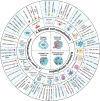Novel strategies for cancer immunotherapy: counter-immunoediting therapy
- PMID: 37055849
- PMCID: PMC10099030
- DOI: 10.1186/s13045-023-01430-8
Novel strategies for cancer immunotherapy: counter-immunoediting therapy
Abstract
The advent of immunotherapy has made an indelible mark on the field of cancer therapy, especially the application of immune checkpoint inhibitors in clinical practice. Although immunotherapy has proven its efficacy and safety in some tumors, many patients still have innate or acquired resistance to immunotherapy. The emergence of this phenomenon is closely related to the highly heterogeneous immune microenvironment formed by tumor cells after undergoing cancer immunoediting. The process of cancer immunoediting refers to the cooperative interaction between tumor cells and the immune system that involves three phases: elimination, equilibrium, and escape. During these phases, conflicting interactions between the immune system and tumor cells result in the formation of a complex immune microenvironment, which contributes to the acquisition of different levels of immunotherapy resistance in tumor cells. In this review, we summarize the characteristics of different phases of cancer immunoediting and the corresponding therapeutic tools, and we propose normalized therapeutic strategies based on immunophenotyping. The process of cancer immunoediting is retrograded through targeted interventions in different phases of cancer immunoediting, making immunotherapy in the context of precision therapy the most promising therapy to cure cancer.
© 2023. The Author(s).
Conflict of interest statement
There are no conflicts of interest to declare
Figures






Similar articles
-
Cancer immunoediting and resistance to T cell-based immunotherapy.Nat Rev Clin Oncol. 2019 Mar;16(3):151-167. doi: 10.1038/s41571-018-0142-8. Nat Rev Clin Oncol. 2019. PMID: 30523282 Review.
-
Cancer Immunoediting in the Era of Immuno-oncology.Clin Cancer Res. 2022 Sep 15;28(18):3917-3928. doi: 10.1158/1078-0432.CCR-21-1804. Clin Cancer Res. 2022. PMID: 35594163 Free PMC article.
-
Immunoediting Dynamics in Glioblastoma: Implications for Immunotherapy Approaches.Cancer Control. 2024 Jan-Dec;31:10732748241290067. doi: 10.1177/10732748241290067. Cancer Control. 2024. PMID: 39353594 Free PMC article. Review.
-
Therapeutic applications of the cancer immunoediting hypothesis.Semin Cancer Biol. 2022 Jan;78:63-77. doi: 10.1016/j.semcancer.2021.03.002. Epub 2021 Mar 9. Semin Cancer Biol. 2022. PMID: 33711414 Review.
-
Recent Advances of RNA m6A Modifications in Cancer Immunoediting and Immunotherapy.Cancer Treat Res. 2023;190:49-94. doi: 10.1007/978-3-031-45654-1_3. Cancer Treat Res. 2023. PMID: 38112999
Cited by
-
Advancing vaccine-based immunotherapy in glioblastoma treatment.Neurooncol Adv. 2025 Jun 24;7(1):vdaf135. doi: 10.1093/noajnl/vdaf135. eCollection 2025 Jan-Dec. Neurooncol Adv. 2025. PMID: 40756669 Free PMC article. Review.
-
Immunotherapy in the Battle Against Bone Metastases: Mechanisms and Emerging Treatments.Pharmaceuticals (Basel). 2024 Nov 26;17(12):1591. doi: 10.3390/ph17121591. Pharmaceuticals (Basel). 2024. PMID: 39770433 Free PMC article. Review.
-
Comprehensive assessment of computational methods for cancer immunoediting.Cell Rep Methods. 2025 Mar 24;5(3):101006. doi: 10.1016/j.crmeth.2025.101006. Cell Rep Methods. 2025. PMID: 40132544 Free PMC article.
-
Inhibitory Checkpoint Receptor TIM-3 as a Regulator of the Functional Activity of Dendritic Cells.Bull Exp Biol Med. 2024 Jul;177(3):287-292. doi: 10.1007/s10517-024-06175-z. Epub 2024 Aug 10. Bull Exp Biol Med. 2024. PMID: 39123087 Review.
-
Dendritic cell therapy for neurospoagioma: Immunomodulation mediated by tumor vaccine.Cell Death Discov. 2024 Jan 6;10(1):11. doi: 10.1038/s41420-023-01782-7. Cell Death Discov. 2024. PMID: 38184649 Free PMC article. Review.
References
Publication types
MeSH terms
LinkOut - more resources
Full Text Sources
Medical

